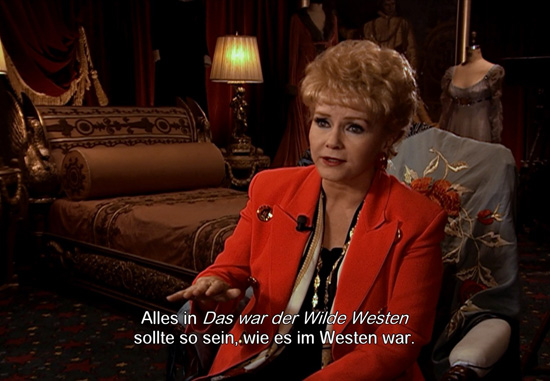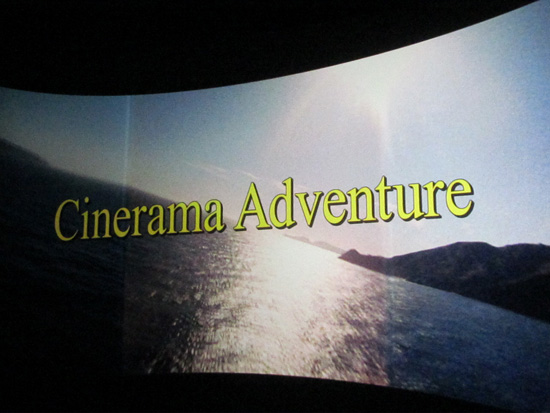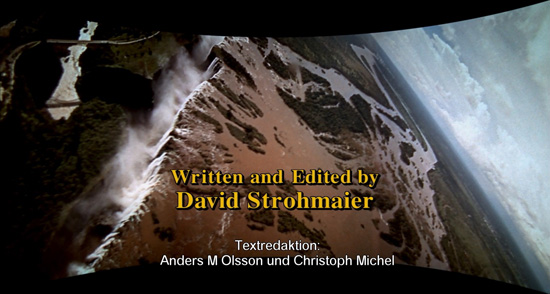Welcome to “Cinerama Adventure” |
Read more at in70mm.com The 70mm Newsletter |
| Written and photographed by: Anders M Olsson, Lund Sweden | Date: 24.01.2017 |
 Debbie Reynolds sadly passed away nine days before our Munich event. Debbie Reynolds sadly passed away nine days before our Munich event.Good evening Ladies and Gentlemen, and welcome to “Cinerama Adventure”, the first show in the series “Kino wie noch nie”. My name is Anders Olsson, and I’m responsible for the German subtitles in the film we’re going to see tonight. That may seem a bit strange since I’m from Sweden and I don’t speak much German, but more about that in a moment. Some of you may have read in the printed program or on the web that tonight’s film was going to be introduced by its writer and director David Strohmaier. Well, unfortunately David couldn’t come, so you’ll have to make do with me. I think David may be excused, since he is busy supervising the scanning of the original three strip negatives of “Windjammer”, a film that was extremely popular here in Germany, so popular in fact that German filmmakers decided to make their own sequel; “Flying Clipper - Traumreise unter weißen Segeln”. Unlike the other films on the “Kino wie noch nie” program, which are features from the 1950’s, Cinerama Adventure" is of a more recent vintage. It was released in 2003 and it’s a documentary, but that doesn’t make it any less entertaining. When I was seven years old in 1961, my mother took me to the Royal Cinema in Malmö, Sweden, where I saw “Seven Wonders of the World” in Cinerama. That film made a lasting impression on me. Like most Cinerama-films, it started with a 4 by 3 prologue on a small screen. But after the prologue, the screen grew, and grew, and grew, until the picture almost filled the entire wall of the cinema. You can imagine me, a seven-year old boy, sitting there with big eyes and dropped jaw. |
More in 70mm reading: Cinema like never before in Munich, Germany The Cinerama Adventure - 2003 update Welcome to “This is Cinerama” Cinerama Remaster in70mm.com's Cinerama page Internet link: |
 On with the show! On with the show!I never could forget Cinerama, and neither could David Strohmaier who had a similar childhood experience. But unlike me, he took it to a whole different level, and made the definite documentary about Cinerama over a period of eight years. After that, he has continued his work by digitally restoring most of the Cinerama titles for theatrical screenings and home viewing. Cinerama is the “mother” of all modern widescreen formats. There had been attempts before to make widescreen films. Some say that they failed because the time was not right, but the early widescreen films from around 1930 lacked two very important elements which Cinerama added - colour and multi-channel high fidelity sound. For many years, Cinerama was all but forgotten. The only place on earth where you could see it – if you had the right connections - was in the home of projectionist and collector John Harvey in Dayton, Ohio. John had transformed his own house into a private Cinerama theatre, and later moved his equipment to a neighbourhood cinema where he successfully ran Cinerama shows every weekend for 3½ years. David Strohmaier went out to make a documentary about it, but found a much larger story, which eventually became Cinerama Adventure. |
|
 "Who
was the moron who made the subtitles for this film? Help, it's me!" "Who
was the moron who made the subtitles for this film? Help, it's me!"The interviews for Cinerama Adventure were made in the mid to late nineties, and over 60 people were interviewed. Many of them have since passed away, so the film is unique and would have been impossible to make today. The most recent loss, and perhaps the most tragic one, was that of Debbie Reynolds who died only nine days ago. Obviously, a documentary about Cinerama would have been pointless if you couldn’t show any clips from the films, but how would you do that? After all, Cinerama is a very complicated process, normally requiring three projectors, a separate sound machine, and a deeply curved screen. Trying to show the films with a single projector on a flat screen, like the one we have here, would make the picture look distorted and bent in the wrong direction. So David Strohmaier and the team of engineers at the scanning lab came up with a digital process called “Smilebox”, which is a way to simulate the appearance of a curved screen. It does this so well that it can, under the right conditions, trick your mind into thinking that you’re really sitting in front of a curved screen. |
|
 A slightly nervous first time lecturer (me!) introduces "Cinerama
Adventure". Image by Stefan Drößler. A slightly nervous first time lecturer (me!) introduces "Cinerama
Adventure". Image by Stefan Drößler.Now, let me tell you a few words about the German translation. When I heard that “Cinerama Adventure” was going to be screened here in Munich, I immediately volunteered to transfer the German subtitles from DVD to the DCP, the digital high definition format that we use in cinemas. Little did I know that the poor anonymous soul who translated the whole thing apparently had little or no knowledge about the subject. An example is that one of the people interviewed talks about “hard tickets”. That only means “numbered seats”, but it had been translated as “tickets made of plastic”. I had great help from Christoph Michel here at the museum, who painstakingly went through the film several times and corrected all the mistakes he could find before I inserted the subtitles into the film. I hope you’ll find the German subtitles satisfactory. I know that David wouldn’t want me to reveal too much about his film before we see it, so I’ll stop here and just say that if you came here not knowing what Cinerama is, you will know in great detail when you have seen the film. Finally, do come back tomorrow night when we’ll screen the first Cinerama film, the one that started it all, “This is Cinerama”. Or in German: “Das ist Cinerama”! Now let’s enjoy “Cinerama Adventure”, and I’d like to dedicate this screening to the memory of Debbie Reynolds. • Go to Cinema like never before in Munich, Germany • Go to Welcome to “This is Cinerama” |
|
| Go: back - top - back issues - news index Updated 22-01-25 |
